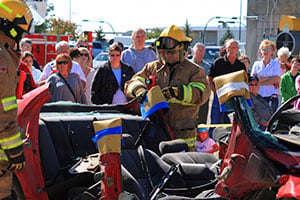The revised ISO Fire Suppression Rating Schedule (FSRS), which identifies criteria used to assess a community’s fire protection services, now provides extra credit for community risk reduction (CRR) activities. It’s a move that fire service leaders around the country are embracing — especially as they discover they can leverage CRR programs already in place and implement new initiatives to boost their ratings.
 “There’s no question that CRR is making an impact on fire and emergency services in the United States,” says Mary Marchone, National Fire Academy (NFA) training specialist. “CRR aligns with municipalities that want a better quality of life for residents and offers value-added services that can only build goodwill between fire and emergency services and the community.”
“There’s no question that CRR is making an impact on fire and emergency services in the United States,” says Mary Marchone, National Fire Academy (NFA) training specialist. “CRR aligns with municipalities that want a better quality of life for residents and offers value-added services that can only build goodwill between fire and emergency services and the community.”
Indeed, heightened interest in CRR recently prompted the Virginia Fire Chiefs Association to devote two full days to the topic. In September, at the chiefs’ statewide conference, “Sound the Alarm: Public Information Officer and Community Risk Reduction Summit,” experts such as ISO field analyst Alvin Turner presented on such topics as “ISO: How Does Community Risk Reduction Fit In?” In his overview of CRR, Turner explained how communities can earn credit for fire inspection, public education, and fire investigation activities they’ve already undertaken, and he offered tips on how a community might enhance CRR activities to earn maximum credit.
“Many fire departments are getting started just by documenting their current activities,” says Turner. “Some departments are working more closely with their local building departments and county and state fire marshals to determine if CRR activities are already being conducted within their communities by those entities.”
Earning extra points for CRR
The FSRS criteria cover three main areas of a community’s fire suppression system: emergency communications, fire department, and water supply. In addition to those factors, FSRS now looks at CRR activities as well.
A community can now receive up to 5.5 additional points as part of the ISO evaluation for its CRR activities. Those extra points provide an incentive to communities that engage in practices designed to prevent fires, without penalizing communities that do not engage in such activities. Three specific CRR areas are evaluated:
- fire prevention code adoption and enforcement (2.2 points)
- public fire safety education (2.2 points)
- fire investigation programs (1.1 points)
A perfect alignment
Sandra Facinoli, branch chief for Prevention and Information, United States Fire Administration (USFA), believes the new CRR section aligns well with the agency’s “Fire Is Everyone’s Fight” campaign, which unites fire services and others in a collaborative effort to reduce home fire injuries, deaths, and property loss. Departments can easily incorporate the campaign’s existing public education program into their CRR initiative while also improving their FSRS scores, she notes.
The expansion of FSRS also aligns well with a key recommendation of the National Commission on Fire Prevention and Control, which published the groundbreaking 1973 report “America Burning.” In that report, the commission recommended that local governments “make fire prevention at least equal to suppression in the planning of fire department priorities.” With the expansion of FSRS criteria to include CRR, communities will not only have an opportunity to improve their FSRS scores but will also help move the country a step closer to realizing the commission’s 1973 vision for safer communities.
Edward H. Kensler is an ISO field analyst and former chief of the Florence Township (New Jersey) Fire Department. He’s a graduate of the National Fire Academy Executive Fire Officer (EFO) program, where he now teachers CRR courses, and a chief fire officer for the Centers for Public Excellence.
